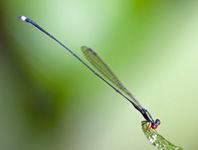Abstract
Chimarra Stephens, 1829 is the second largest genus of Trichoptera, with more than 700 extant species worldwide (Morse 2015). Currently 4 subgenera are recognized: Chimarra Stephens, 1829, known from all zoogeographic regions; and Curgia Walker, 1860, Chimarrita Blahnik, 1997, and Otarrha Blahnik, 2002, all of them confined to the Neotropics (Blahnik & Holzenthal 2012).
References
Blahnik, R.J. (2002) Systematics of Otarrha, a new Neotropical subgenus of Chimarra (Trichoptera: Philopotamidae). Systematic Entomology, 27, 65–130.
http://dx.doi.org/dx.doi.org/10.1046/j.0307-6970.2001.00166.xBlahnik, R.J. & Holzenthal, R.W. (2004) Collection and curation of Trichoptera, with an emphasis on pinned material. In: Chamorro-Lacayo, M.L. (Ed.), Nectopsyche, Neotropical Trichoptera Newsletter, 1, pp. 1–26.
Blahnik, R.J. & Holzenthal, R.W. (2012) New Neotropical species of Chimarra (Trichoptera, Philopotamidae). Zookeys, 184, 1–33.
http://dx.doi.org/10.3897%2Fzookeys.184.2911Calor, A.R. & Mariano, R. (2012) UV light pan traps for collecting aquatic insects. EntomoBrasilis, 5 (2), 164–166.
http://dx.doi.org/10.12741/ebrasilis.v5i2.187Morse, J.C. (Ed.) (2015) Trichoptera World Checklist. Available from: http://www.clemson.edu/cafls/departments/esps/database/trichopt/ (accessed 14 February 2015)
Mittermeier, R., Gil, P.R., Hoffman, M., Pilgrim, J., Brooks, T., Mittermeier, C.G., Lamoreux, J. & Da Fonseca, G.A.B. (2005) Hotspots revisited: Earth’s biologically richest and most threatened terrestrial ecoregions. Mexico, CEMEX, 392 pp.
Ratter, J.A., Ribeiro, J.F. & Bridgewater, S. (1997) The Brazilian Cerrado vegetation and threats to its biodiversity. Annals of Botany, 80 (3), 223–230.
http://dx.doi.org/dx.doi.org/10.1006/anbo.1997.0469Santos, A.P.M., Dumas, L.L., Jardim, G.A., Silva, A.L.R. & Nessimian, J.L. (2015) Brazilian Caddisflies: Checklists and Bibliography. Available from: https://sites.google.com/site/braziliancaddisflies/ (Accessed 14 February 2015)

